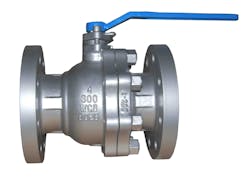About the author: Charles Erickson is project engineer and technical lead for mechanical plumbing products for UL LLC and is a member of the IAPMO Z1157 Technical Subcommittee. Erickson can be reached at [email protected] or 847.664.2494.
Most people encounter valves in their everyday lives without giving them much thought. We assume they will open easily, not leak and stand the test of time while maintaining the quality of our drinking water. All of these characteristics are taken for granted, but are the result of product standards such as IAPMO/ANSI Z1157 – Ball Valves. This standard specifies the requirements for materials, physical characteristics, performance testing and markings that make ball valves a seamless part of our lives.
IAPMO/ANSI Z1157 covers ball valves in nominal pipe sizes 1⁄8 to 4, with minimum rated working pressure of 860 kPa (125 psi) at 23°C (73°F), intended for use in water supply and distribution systems.
Materials
The standard has both mechanical property and toxicity requirements for materials used in the valve body and other wetted parts. These requirements help ensure that valves function properly and do not impart undesirable chemicals to drinking water.
The mechanical properties of plastics (PVC, chlorinated polyvinyl chloride, polypropylene and high-density polyethylene) are verified by compliance with ASTM Intl. or Canadian Standards Assn. (CSA) material standards. In addition to ASTM or CSA material standards, HDPE components must have a strength and pressure rating by the Plastics Pipe Institute. The mechanical properties of metals follow common industry standards. The requirements include the percent of copper in copper alloys and specification of certain stainless steels.
In addition to the mechanical properties for the materials, there also are toxicity requirements for products intended to convey or dispense water for human consumption through drinking or cooking. These products are required to comply with the requirements of NSF/ANSI Standards 61 and 372. NSF/ANSI 61 establishes minimum health effects requirements for products that are in contact with drinking water. NSF/ANSI 372 establishes requirements for the determination of lead content of products that are in contact with drinking water.
Physical Characteristics
IAPMO/ANSI Z1157 addresses the physical characteristics of the valves by considering the “port,” end joints and connections, and seals and handles. These requirements provide the basis for ease of installation and leak-free operation.
Both full-port and reduced-port valves are considered by IAPMO/ANSI Z1157. Much like the materials properties, full-port valves must meet the dimensional requirements of the specified ASTM or CSA standard. Ball valves that do not comply with the dimensional requirements are considered reduced-port valves and must be labeled as such.
Several end joints and connections are covered by IAPMO/ANSI Z1157. Press connections, push-fit, metal insert, threads, solvent-cemented, solder, cold expansion, stub ends, and even integral flexible connects are included. Again, like the materials properties, all of the mentioned joints and connections must comply with the specified ASSE Intl., ASTM, American Society of Mechanical Engineers or CSA standard.
The requirements of seals and handles are more direct. Rather than referencing the most appropriate standard, the requirements are stated directly and include common features such as that the handle shall “be removable only through the use of tools” and “indicate the port position on the ball valve.”
Performance Testing
The standard prescribes several tests to assess the performance of ball valves. These tests include hydrostatic pressure, valve closure, handles, lifecycle, burst pressure, high temperature and alternative materials. As many of the test names suggest, they are focused on ensuring that the ball valves do not leak under various pressure and temperature conditions or after a period of use. In short, these tests evaluate the functionality and longevity of the ball valve.
To give an example of what the testing typically consists of, let’s look at one of the more interesting tests: lifecycle. The lifecycle test requires installing the ball valve and cycling it from closed to open to closed 5,000 times over about eight hours. After the 5,000 cycles have been completed, the ball valve is inspected for leaks, and the torque necessary to operate the ball is measured and compared to a required limit.
Marking
As with most standards, IAPMO/ANSI Z1157 has product marking requirements. These include the nominal size, maximum rated working pressure, etc. The markings must be permanent, legible and visible after installation. They may be applied to the ball valve body or handle, or using a hang tag.
What to Expect With Certification
Product certification by an accredited third party such as UL LLC is the best way to verify that a ball valve design meets the requirements of any standard, including IAPMO/ANSI Z1157. If you are seeking third-party certification, it is recommended that you work with your material suppliers to gather as much information as you can regarding the materials used in the construction of the ball valves. This information will be useful for determining the mechanical properties of the materials and also will help if the ball valve will be used in drinking water applications where NSF/ANSI 61 or 372 is required.
Finally, be prepared to provide an example or product drawing of each type of end configuration, product design and size for examination.
Standards such as IAPMO/ANSI Z1157 allow the public to take the mechanical performance, health effects and longevity of plumbing products for granted. The requirements of the standard cover the material, physical characteristics, performance testing and marking requirements that are important to consumers and manufacturers alike. Continue to make plumbing products a seamless part of our everyday lives and consider having your product evaluated to IAPMO/ANSI Z1157.
Download: Here
